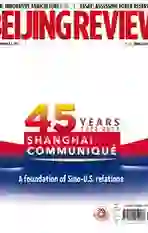Understanding China’s Forex Reserves
2017-03-29ByLanXinzhen
By+Lan+Xinzhen
Statistics issued by Chinas central bank in early February revealed that Chinas foreign exchange(forex) reserves stood at $2.9982 trillion at the end of January, a drop of $12.3 billion compared to the previous month. Upon receiving the data, some analysts expressed concern, claiming that Chinas forex reserves had breached the psychological threshold of $3 trillion.
The so-called “$3 trillion psychological threshold,”however, is neither a scientific nor an accurate expression, as a countrys forex reserves are not a fixed number but something that keeps fluctuating according to a set of fi nancial activities like the countrys inbound and outbound investments, as well as residents forex activities.
The forex reserves are crucial for Chinas economy. Concern for the psychological line of demarcation is essentially apprehension over whether the reserves will continue to decrease. Here, we have to clarify two questions: First, why has the amount fallen? Second, what amount would China consider to be appropriate?
The forex reserves relate to the internationalization level of a countrys economy. Since 1978, the year China began adopting the policy of reform and opening up, the nation has attracted a huge amount of international investment and registered a favorable balance of trade. This led to the accumulation of Chinas forex reserves, which jumped from $167 million in 1978 to $3.84 trillion in 2014.
These figures once triggered concern among Chinese economists, who were afraid that the fl ood of foreign capital would affect the economy negatively. Meanwhile, the practice of solely purchasing U.S. treasury bonds for hedge was widely criticized.
Since 2014, Chinas forex reserves have been in decline. There are several reasons for this trend.
To begin with, other major foreign currencies such as the euro are depreciating against the U.S. dollar. Since part of Chinas forex reserves are in these currencies, their depreciation has contributed to the decline of the reserves.
Second, most of Chinas forex reserves are spent purchasing foreign assets like U.S. treasury bonds. When the price of these assets begins to drop, the value of Chinas forex reserves also falls.
Third, as the worlds second largest economy, China is spending more and more of its forex coffer on imports and outbound investment, as well as on residents studying and traveling abroad. For example, Chinas outward investment cost $17 billion in 2016, up 44.1 percent over the previous year.
Fourth, since 2015, the renminbi has undergone sharp depreciation against the U.S. dollar. This has incurred anxiety about Chinas economic development, particularly in 2016 when it depreciated 6.5 percent, the sharpest drop within a year since 1994. In response, China used around $300 billion from its forex reserves to stabilize the renminbis exchange rate. Some American politicians have accused China of devaluating the renminbi through manipulation. If China had not intervened, we could have witnessed a drastic reduction in the Chinese currencys value. The continuous depreciation of the renminbi is detrimental to both the Chinese and U.S. economies.
There is no need to worry about the drop of Chinas forex reserves, as the country still holds the largest reserves in the world, accounting for 28 percent of the global total. Nevertheless, there are concerns that if Chinas reserves continue to decline, its international payments will be affected. Then, how many reserves are enough for China?
Actually, there is no exclusive answer to this question, as there is no unifi ed international or domestic standard for a rational level of forex reserve holding. Such a fi gure would depend on a raft of factors, such as a countrys macroeconomic conditions, its level of economic openness, the ability to make use of foreign capital, international fi nancing ability, as well as the maturity of a countrys fi nancial system.
If we take globally recognized indexes, such as the value of imports in three to six months or 100 percent of short-term external debt, as the criterion,$2 trillion in reserve is enough for China.
Given the global economic situation in 2017 and Chinas capital fl ows, the foundation for Chinas crossborder payments remains stable. Besides, the pace of the renminbis internationalization is expected to accelerate. Therefore, Chinas forex reserves will continue to play a positive role in facilitating the countrys economic development in the coming years.
